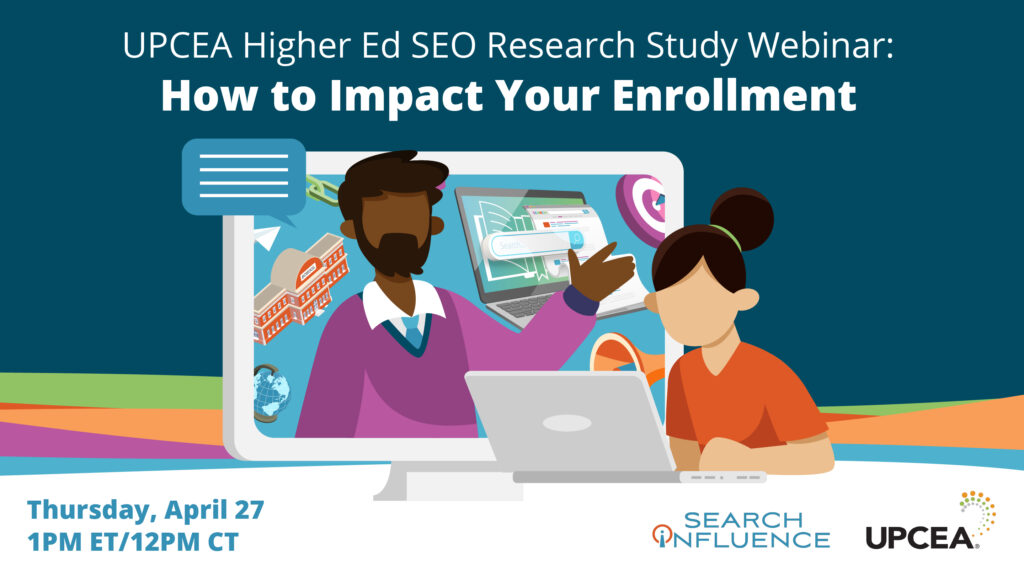Improving SEO In Higher Education Must Be a Priority: Insights From UPCEA Webinar
May 11th, 2023 by
Priority: Improving SEO in Higher Education
Search Influence joined the UPCEA team, Jim Fong and Bruce Etter, as they unveiled the highly anticipated UPCEA Higher Education SEO Research Study in a lively and informative webinar.
We’re grateful for the engaged audience, who brought us compelling questions. It was obvious from what they asked that we had some tech-savvy folks attending.
For those who have yet to dive into the study, we’ve got you covered with a summary of the key takeaways:
- Marketing and institutional leaders see SEO as foundational but admit their PCO units lack SEO strategy.
- Institutional leadership often lacks reporting.
- UPCEA members performed poorly in an SEO audit.
In fact, in the SEO readiness audit of 100 random UPCEA member institutions, only 19% had an excelling score.
And to pre-answer a question some may ask, this is an UPCEA metric. Search Influence collaborated on the factors, but the grades came from the research itself.
Why Is SEO Important in Higher Education?
From our discussions with higher ed marketing leaders, individual PCO units spend significant dollars on paid online advertising and next to nothing on SEO.
The ROI of SEO is obvious to anyone paying for paid search. Keywords in search can inform your SEO strategy. If you’re paying for it and you don’t rank #1, that’s an opportunity.
Any department that has in-house web management, social media, or content creation staff has the makings of an SEO team already in place.
In short, SEO is foundational — most know it, and few are doing it.
Higher Education SEO Questions From the Audience
The following questions came directly from the audience in the webinar Q&A section. We clearly had a smart audience and appreciated all the great questions.
Q: Which other tools do you use for keywords?
In the webinar, we talked about how we used Semrush data for part of the SEO audit done by the UPCEA team, hence the “other tools.”
A: One of the best “keyword” tools any organization can use — especially resource-strapped higher ed marketers — is Google Search Console. GSC gives you the ability to see page-by-page and query-by-query where your opportunity is.
It also shows you what Google thinks you’re relevant for already, which can identify a shorter path to execution.
In addition to GSC, at Search Influence, we rely on a few tools depending on the use case:
- Ahrefs – Great overall tool, with an especially good view of page and subdomain level authority
- Semrush – Another great tool overall, with reporting and site auditing capabilities
- Surfer SEO – This one is newer in our toolbox. It’s not a pure “Keyword” tool. It’s actually an optimization tool that can help identify content clusters for building topical authority, as well as auditing and outlining SEO optimization of individual pages.
Q: How do you navigate building backlinks without buying backlinks in a way that Google “disapproves” of?
Google says, “Any links that are intended to manipulate rankings in Google Search results may be considered link spam.”
That doesn’t mean that all “backlinks” are bad. It just means you should look for good links. What is a good backlink? A good backlink is one that is relevant, directional, and on a site likely to drive real users.
Just because you ask for it doesn’t make it bad. It’s about intent.
Some easy opportunities:
- Local citations, such as directory listings
- Other schools within your parent university or college
- Institutions you collaborate with in real life
- Local organizations with which you support or partner
Q: Are internal links counted as backlinks?
No. They’re internal links, which are awesome, too.
There are a bunch of great things about internal links:
- You get to control the anchor text used.
- They can help to reinforce topical authority, e.g.:
- You have portfolio pages
- Which have program pages
- Who have individual courses and
- Instructors and
- Resources and
- Etc.
- Which have program pages
- You have portfolio pages
- They’re navigational — in other words, they support the student journey, moving prospects down the funnel toward their eventual application.
Q: Advice on structuring some complete revision of websites? Would you recommend program by program, or another way?
This is a classic “it depends” kind of situation. From a business and organizational perspective, what matters most?
Is it most important to categorize by type, e.g., on-campus, hybrid, certificate, non-degree, etc.?
Or by program, e.g., homeland security, human resources, organizational management, etc.?
Once you make that decision, stick to it, build your silos — but not too deep — and think about reasonable interlinking between them.
Q: From the user side, have you noticed any impact on CTR with truncated title tags?
Not really, but it’s not something we’ve studied.
Q: Any concern with title tags and truncating on Google?
No. In our opinion, this is an opportunity. It’s Google telling you what great looks like. What we’ve seen is that these are most often picked up from some on-site content.
If you find it happening, consider recrafting your title tag and your leading H1 to match. That should give the machine what it wants.
Q: Any advice on how to shift the narrative that SEO is free or should be very low cost and doesn’t need as much investment?
Echoing what I said above:
The ROI of SEO is obvious to anyone paying for paid search. Keywords in search can inform your SEO strategy. If you’re paying for it and you don’t rank #1, that’s an opportunity.
The keyword ranking tool we use just came out with a new “forecasting” feature. It allows you to build a keyword group, assign dollar value and conversion rate, and see the business impact of moving from position X to position Y over time.
We looked at paid search accounts, grabbed keywords we know to convert, and built forecasts. The impact, in many cases, is staggeringly obvious.
Reach out and we can run a limited version for you.
Conclusion
The UPCEA Higher Education SEO Research Study shed light on the critical need for SEO in PCO marketing and beyond. Many, perhaps most, institutions have a lot of room for growth and optimization.
It’s crucial for universities to recognize the value that SEO can bring to their marketing and seize the opportunity to be present for all their prospective students.
The webinar showcased that, while leaders acknowledge SEO as a foundational element, there’s a gap in implementing effective strategies within PCO units. Additionally, the need for improved reporting for institutional decision-making and better SEO performance among UPCEA members was clear.
It’s time for universities to embrace SEO and reap the benefits of higher visibility, engagement, and growth.
We encourage you to join the conversation, share your own experiences, and learn from others. Feel free to comment below to keep the conversation going.
If you’re looking for expert guidance to help you navigate the world of SEO, don’t hesitate to get in touch with Search Influence.
We’re here to support you in optimizing the potential of your organization.
Images



